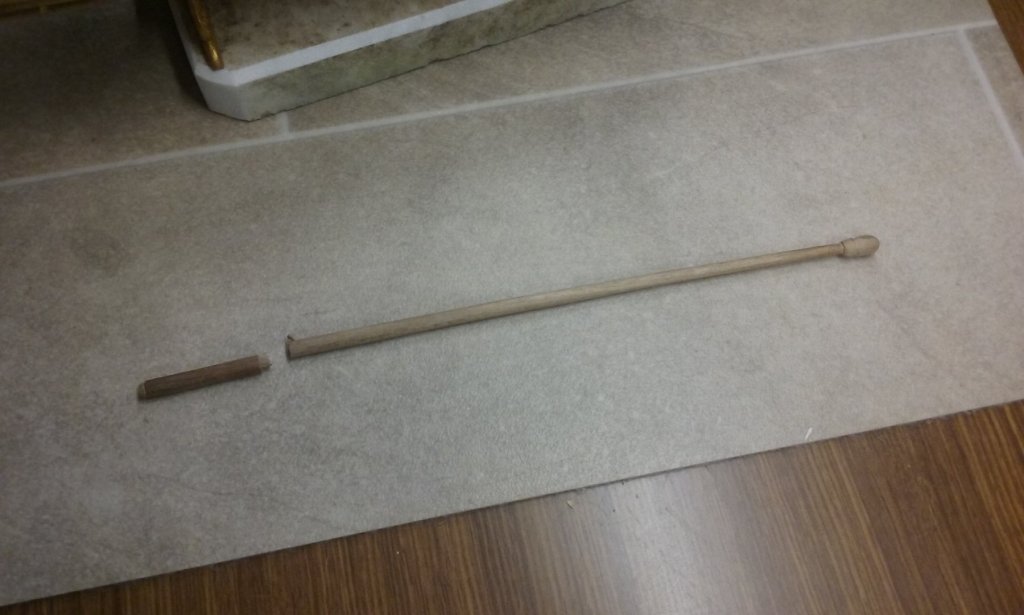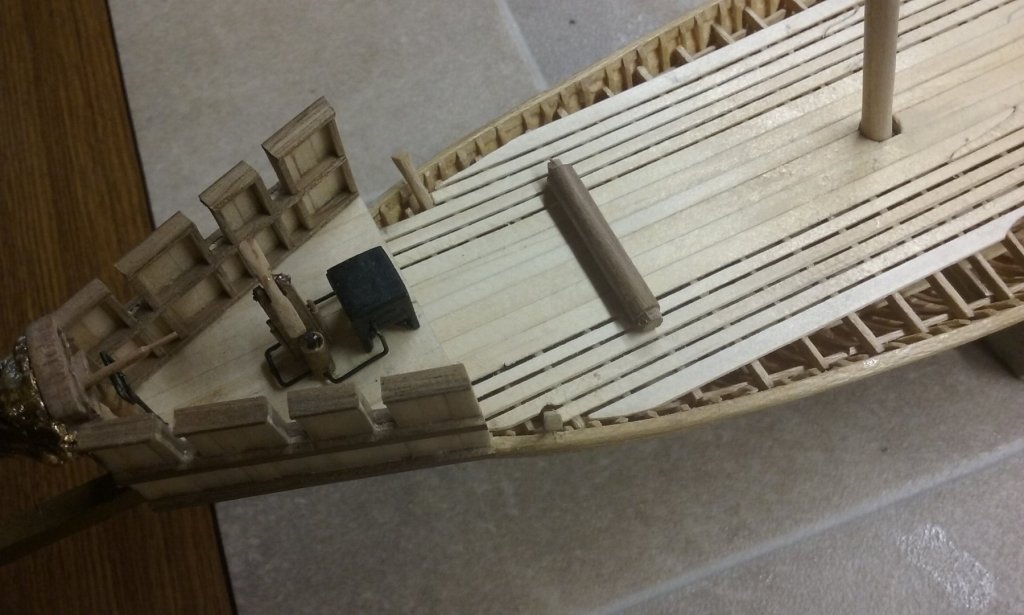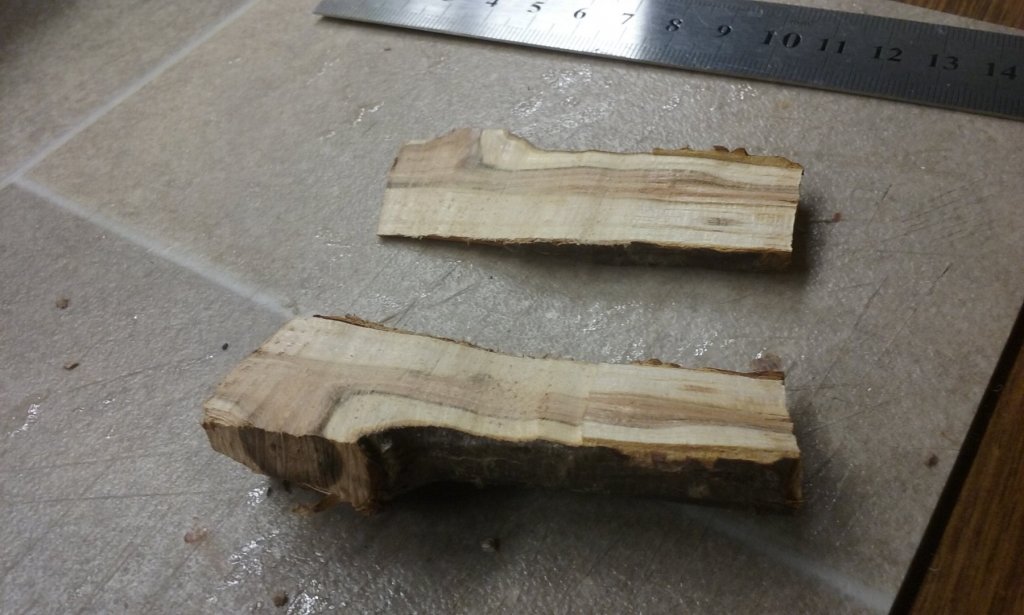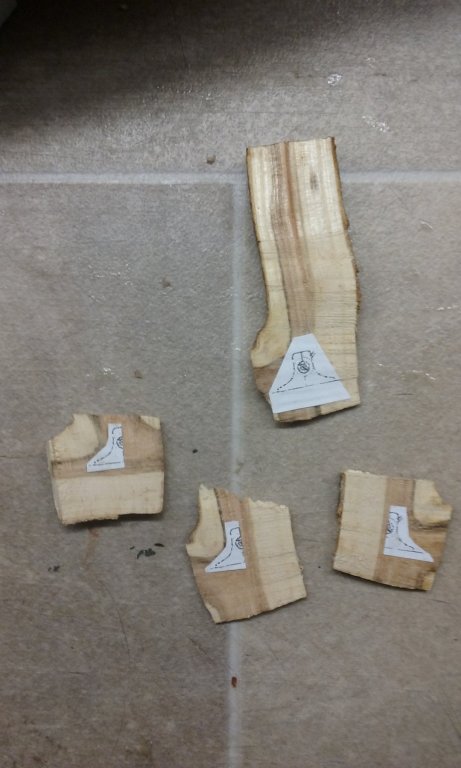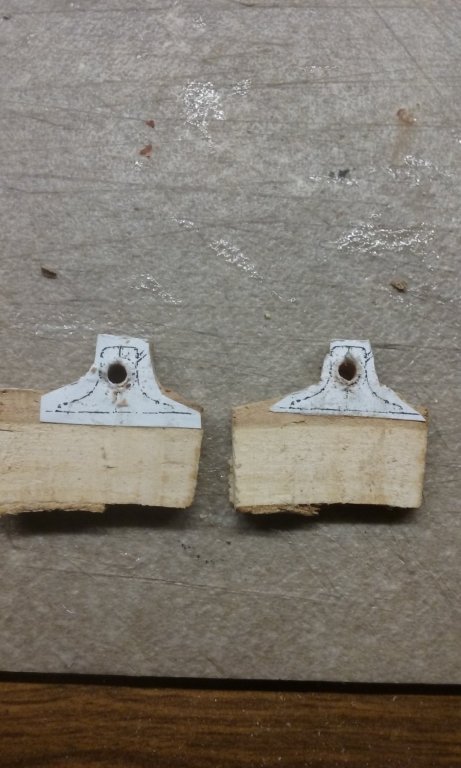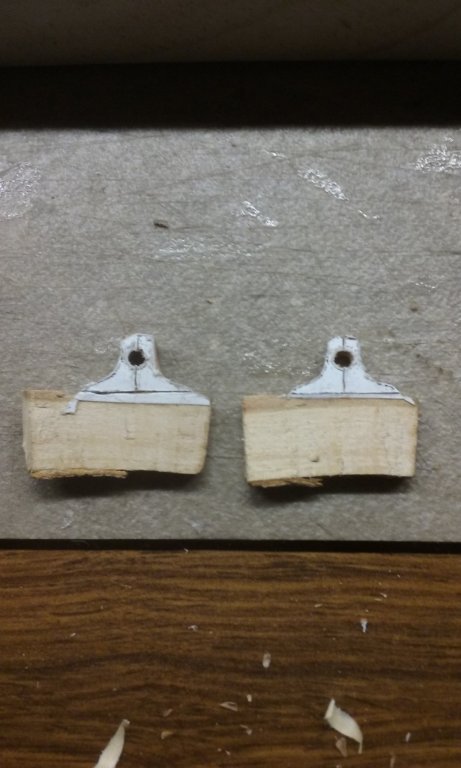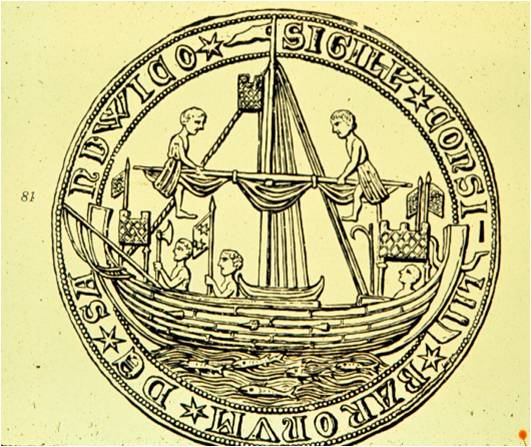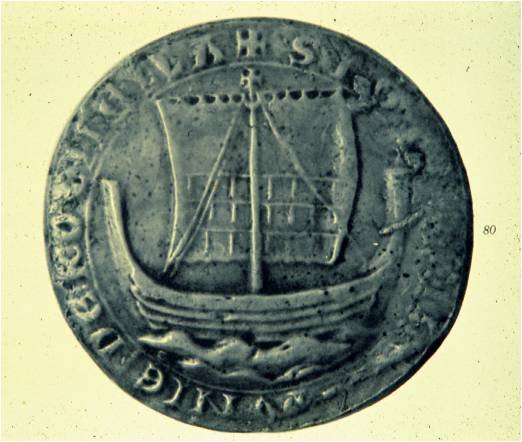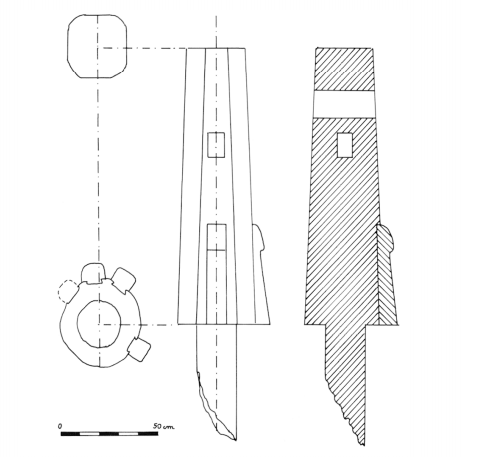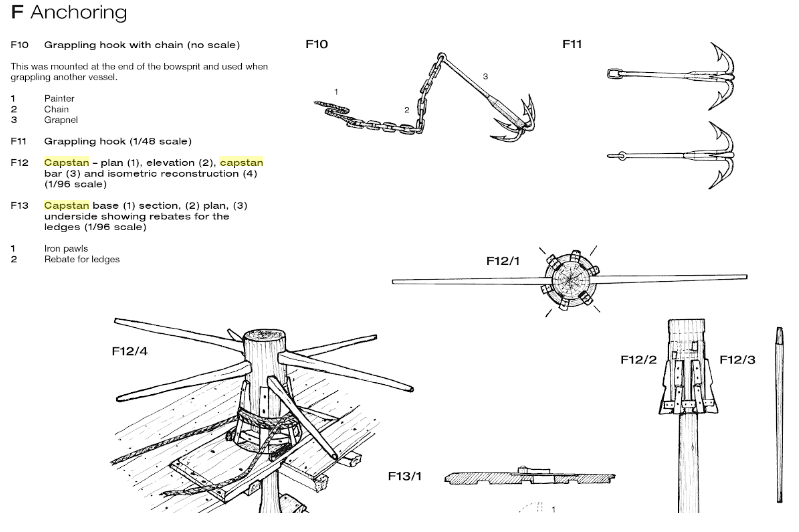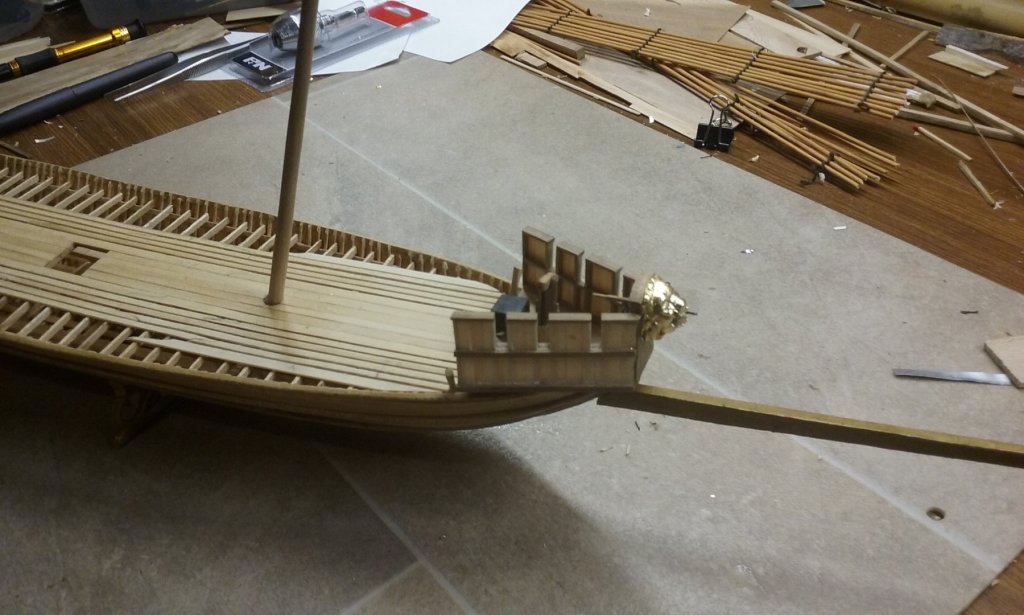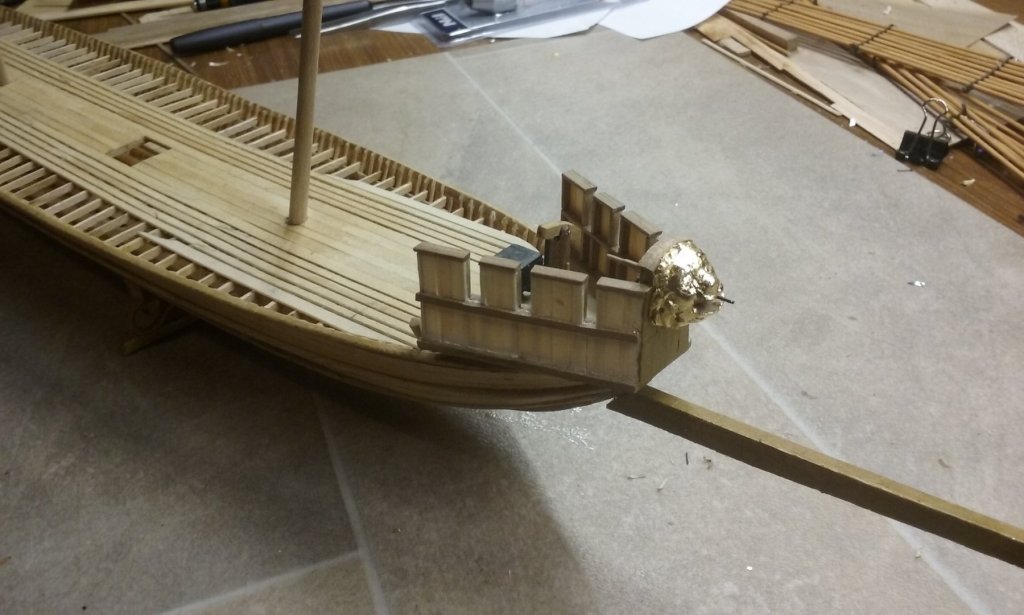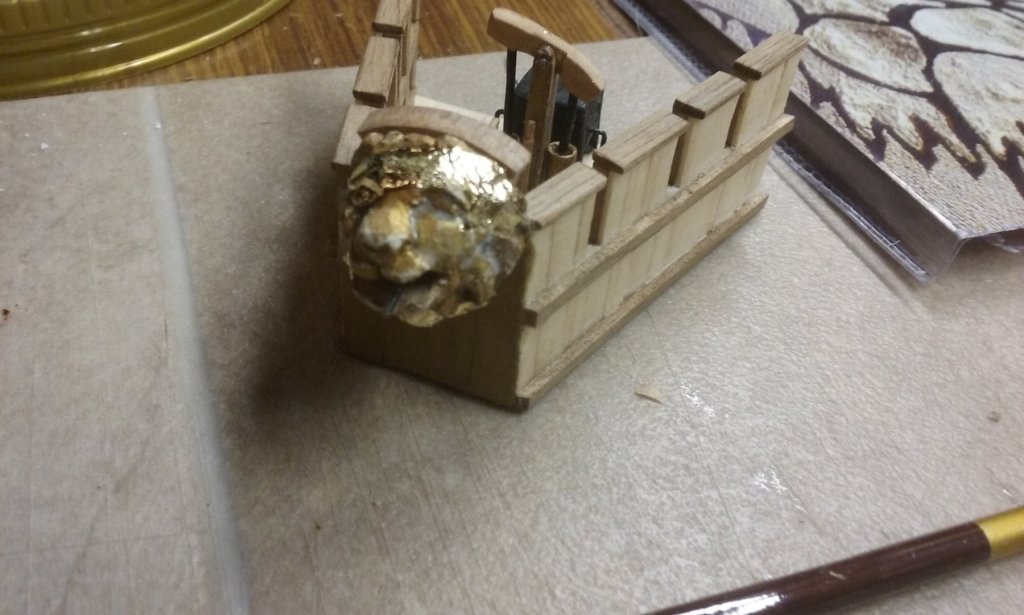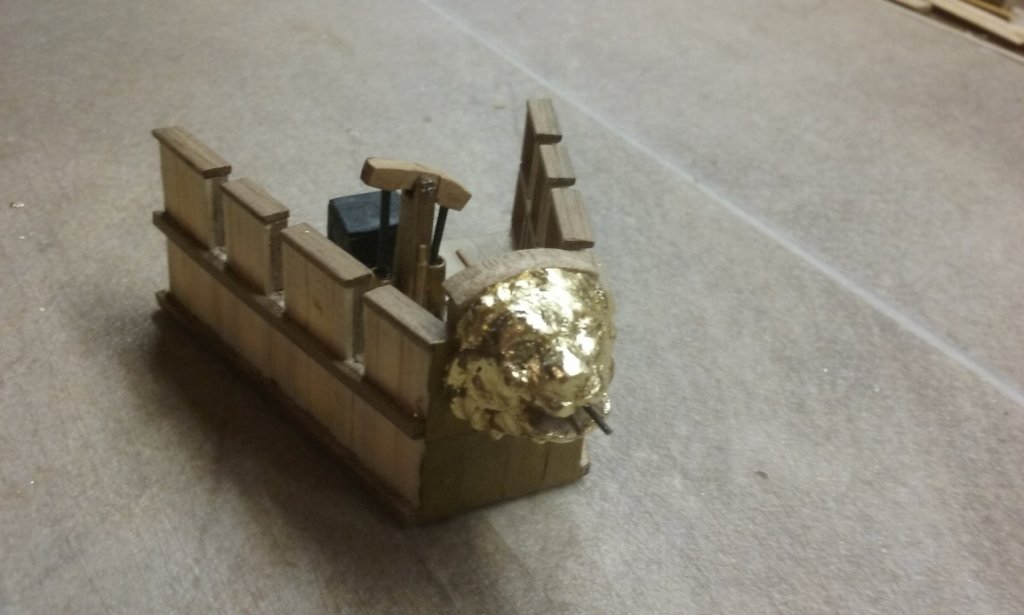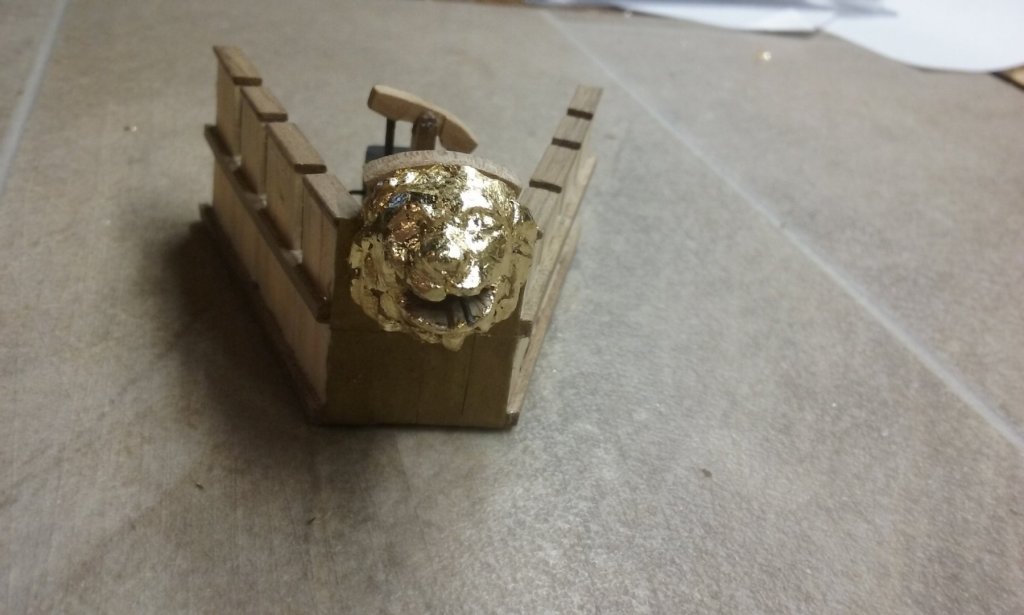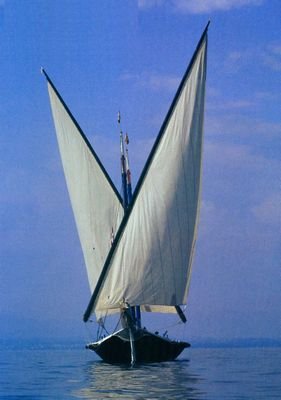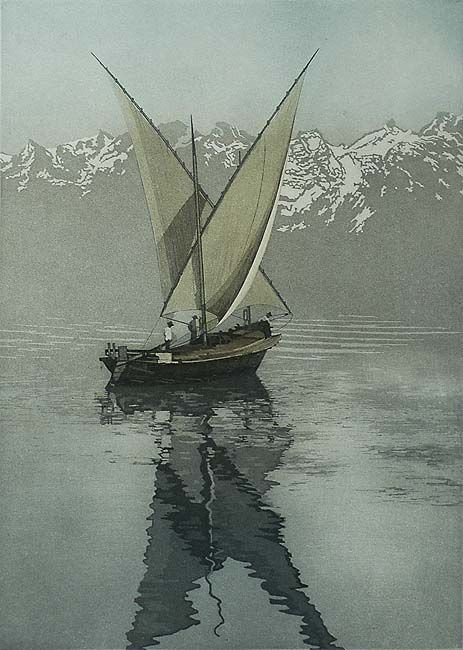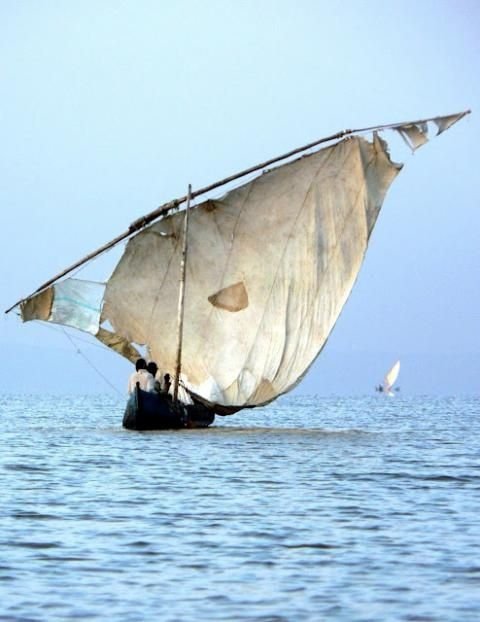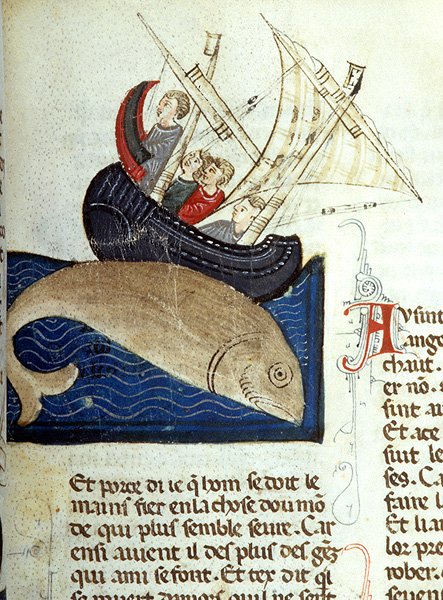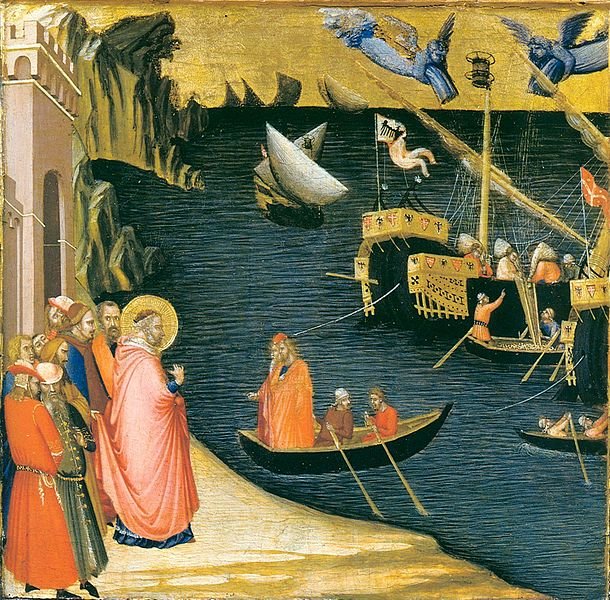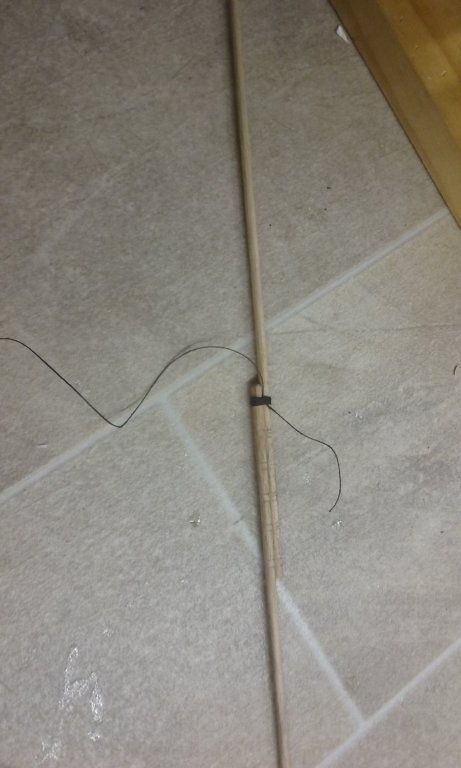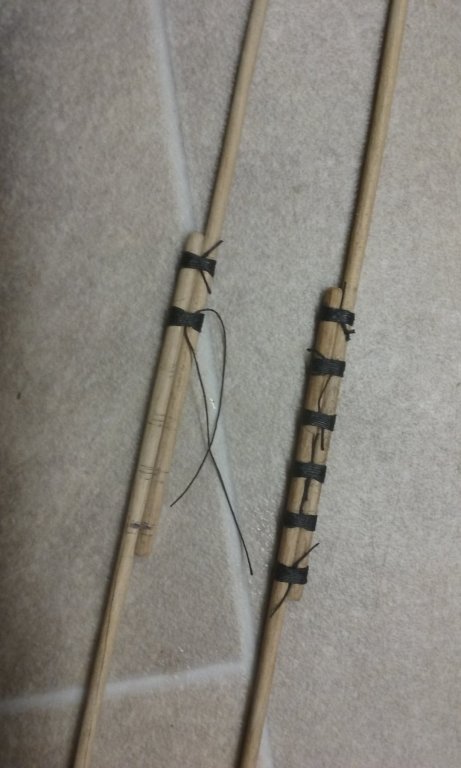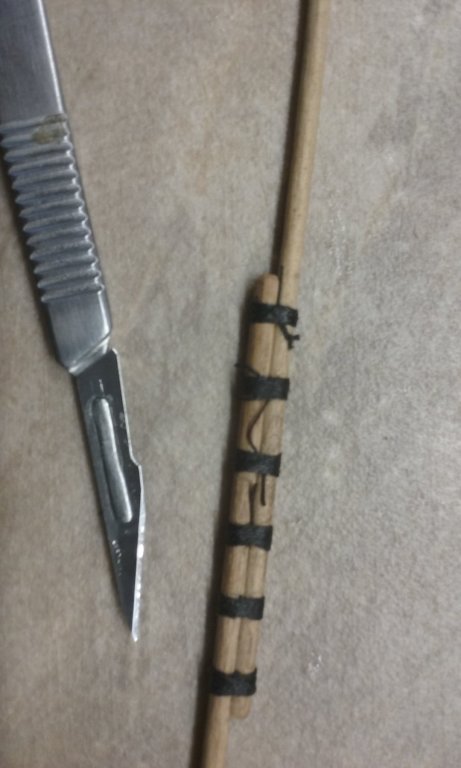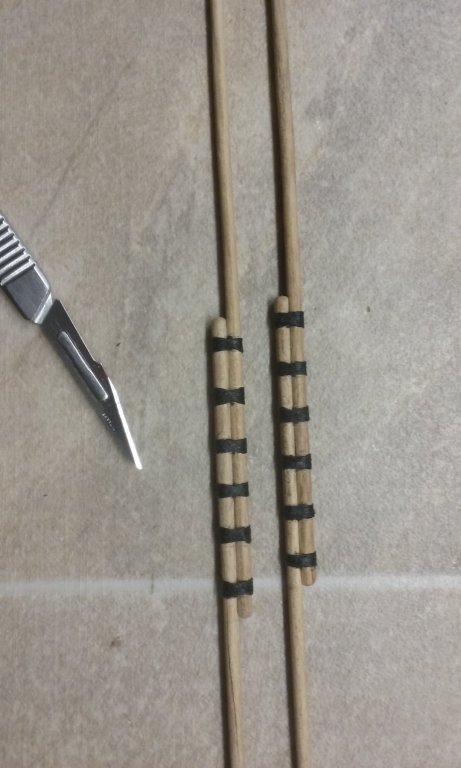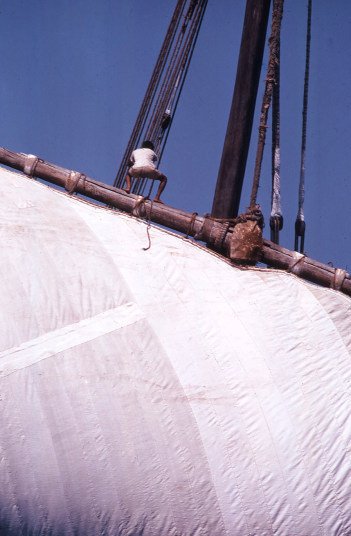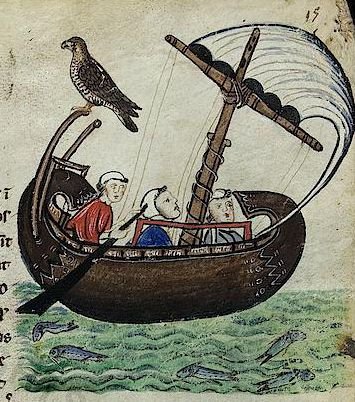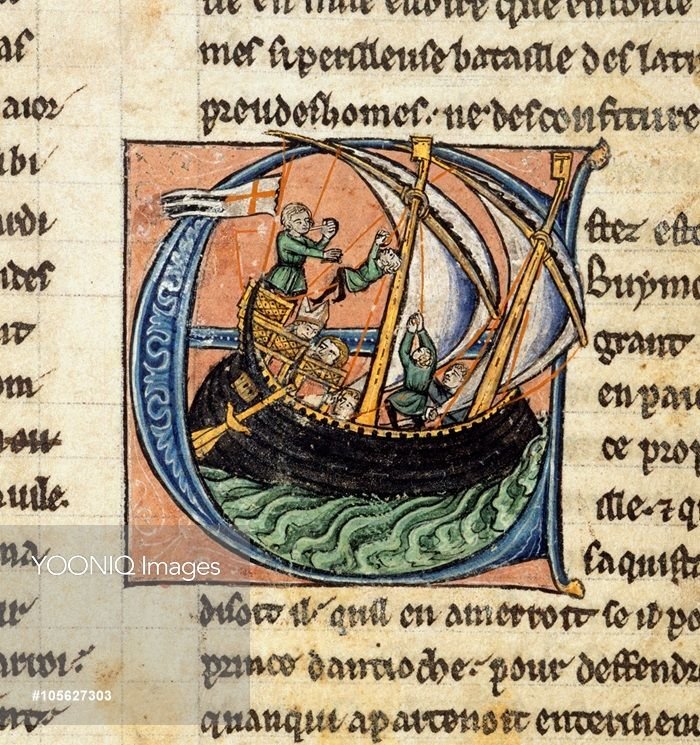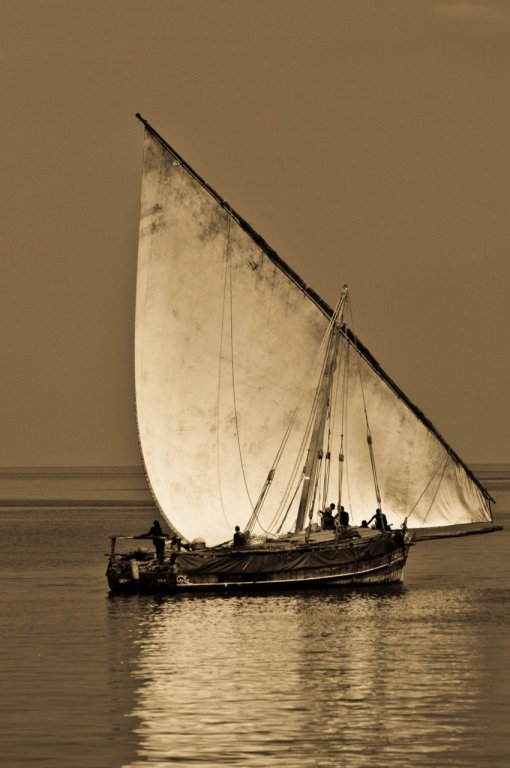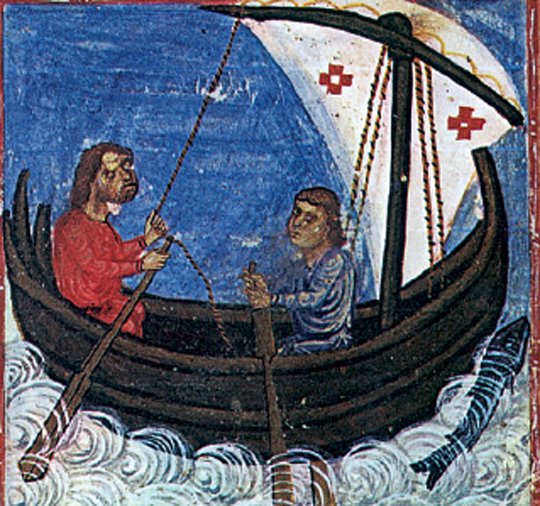-
Posts
7,989 -
Joined
-
Last visited
Content Type
Profiles
Forums
Gallery
Events
Everything posted by Louie da fly
-
Thanks for all the likes. Nikiphoros, the 12th century illustrated copy of the Synopsis Historion by Ioannis Skylitzes held in the Madrid Biblioteca Nacional has quite a few pics of galleys with banners. I'll be following this one, as it's a ship carrying the Emperor. The Lascaris double-headed eagle and the banner with the repeated letter B (as on your post, but in red and yellow) didn't come into use until a couple of centuries later. As far as I know, the sail would have simply been the natural colour - certainly there's no evidence to suggest anything else. And murex would have been prohibitively expensive - though several surviving pieces of Byzantine fabric in "Imperial purple" turn out to have been dyed with madder red and woad blue to make purple. Steven
-
Working on the windlass, using the Mary Rose's windlass as a model - it's the earliest intact windlass I know of. If anyone knows of one closer to the 11th century, please let me know. I still have a problem with this windlass - there is no pawl, so I don't know how to keep the windlass from unwinding if the bars are released - perhaps the cable was just made fast to bitts or cleats or something when it was pulled up far enough. I recycled a mast which had bowed and had to be discarded, and cut a bit off it to make the barrel of the windlass. I started out using a bit of branch from a plum tree I'd been holding on to for years, as it's got a join between the branch and a lesser branch, which should give a good grain for making knees. I cut four slices from it, photocopied the Mary Rose windlass down to scale and glued four L-shaped segments for the two ends (two for each end) onto them. But it turned out I'd cut two of the pieces too thin. As I only had one piece of wood, I thought I'd wasted my efforts. Then I realised the piece of wood actually had a T-shaped grain, so I could make each of the ends in a single piece and carve a fake join between the two "halves". Unfortunately, this meant the grain pattern in the two end pieces was continuous instead of being in two halves. But I think I can live with that - if all else fails, I'll paint the ends to hide the grain. Steven
-
Looks very good, Tom, and the scale looks right. I agree about the colour for yours. I'll be using tulle for my Great Harry, but as it's at 1:200 I find that a lighter colour vanishes at that scale, so I used black. Anyhow, the nettings on 16th century ships were pretty much permanently fitted, right over the top of the decks, and weren't used to store hammocks in between times. Steven
-
A wonderful project to undertake, Chidokan. I find ships of this period fascinating. I'm currently restoring my own scratch-built model of Mary Rose's big sister, the Henry Grace a Dieu (or Great Harry) that I built when I was 17. That was before Mary Rose was raised, so a lot of the details in my own model are wrong, but I think it's worth returning it to its original glory. You'll find everybody here very helpful. Don't be afraid to ask questions, and don't worry if you make mistakes - we all do, even the best of us (in which group I don't include myself). And have fun with it! By the way, a heads-up on the Jotika model. The Mary Rose's forecastle has never been found (though I live in hope), and most reconstructions of her, including the one at the Mary Rose Trust, show her with a forecastle I believe to be incorrect, and more appropriate to a galleon than to the Mary Rose. I raised this issue on this forum at The forecastle still hasn't been found, but I'm still of the opinion that the "official" one isn't correct. Look at the Anthony Roll picture - doesn't look at all like a galleon's forecastle. Perhaps you might consider "bashing" the forecastle to be more like the Anthony Roll one. Regarding the discrepancy between the Anthony Roll and the number of guns believed to have been on board the wreck, there's an analysis of how many of each type of gun she carried at https://en.wikipedia.org/wiki/Mary_Rose, which might be of help. Good luck with her. A very well worthwhile model to make. Steven
-
Still remembered. The sacrifice of all those young men for a campaign pretty much doomed at the start, because the Turks knew they were coming and were well prepared. Steven
-
I agree. Galleons had certainly made their appearance by 1545, with the characteristic beakhead and low forecastle. It will be interesting to know whether this vessel is one of them, or is old-style. I think I'd be expecting the new type in this case Steven
-
I've bookmarked this - it will be interesting to see more as the archaeological reports come in. This is really later than "Viking" times - just before "nefs" with castles in bow and stern, and I'd like to see what if any evolution can be seen from the intervening centuries. This is the seal of the coastal town of Sandwich, from 1238, which is about as early as these castles seem to have come into use. The 1188 ship is more likely to have looked like this: which is almost identical to Viking vessels. The differences are likely to be in the details, and the fact that this was a merchant ship not a warship. Steven
-
Very interesting. I look forward to hearing more about this one. Built about thirty years later than Mary Rose, but very close in time to Mary Rose's rebuild in 1536. It will be interesting to compare the two. Steven
-
The capstan of the Genoese ship Lomellina, built in 1503, has slots for two bars,each of which passes right through the capstan. The slots are at different heights above the deck. A reconstruction of the Mary Rose's capstan (with removable bars) is shown below. This seems identical to the one Patrick is making. This illustration can be found at https://books.google.com.au/books?id=MSCGCgAAQBAJ&pg=PA108&lpg=PA108&dq=mary+rose+capstan&source=bl&ots=EjQXJE-eU7&sig=ACfU3U3vIvX3cjv7dF9GZQA9g-OfSPourA&hl=en&sa=X&ved=2ahUKEwiCyu2auM_hAhWJfysKHUzvC70Q6AEwEXoECAgQAQ#v=onepage&q=mary rose capstan&f=false It seems unlikely to me that a capstan, even as early as the 16th century, would have its bars permanently in place getting in the way. Steven
- 756 replies
-
- galleon
- golden hind
-
(and 2 more)
Tagged with:
-
A very nice exposition of how Venice came to have such a wide-ranging Empire. The only thing I'd add is that Venice, having helped destroy Europe's bulwark against the expanding influence of the Ottoman Turks, lost its own "Empire" to them in the following centuries. Poetic justice? Steven
- 263 replies
-
- nave tonda
- round ship
-
(and 2 more)
Tagged with:
-
Dick, I'm inclining the same way. My masts are simple poles, as I haven't seen anything in contemporary Byzantine pictures to suggest they were built-up (not that this is any kind of proof - but it's all I've got to go on). By the way, I hadn't previously noticed that the mast in the left hand picture in your post seems to be made out of a barber's pole! Again, I agree. However, though the dhows are 19th century I think there's a fair chance they are "traditional" and have changed less than Western European examples. And I'll be using the simplest and arguably most "primitive" examples as a model to work from, on the basis that they're likely to be closer to mediaeval practice than any others.
-
That's right, Carl. A very small brush indeed. Usually used for fine detail work. And after the glue was dry (I used dilute PVA) I buffed the exposed surfaces with the end of my finger. Here is perhaps a better idea of what the lion's head will look like when it's in place: Steven
-
I've painted the "heat shield" at the front of the forecastle to look like bronze plating, and covered the lion's head with gold leaf, in line with the description in the Alexiad. The photos don't really give a good impression of just how shiny it is. Just starting out: And completed: A lot of very fiddly work and a certain amount of cursing. But I feel more confident now that I can put gold leaf on things fairly well. Still a lot to learn but not quite as terrified of getting it wrong as I was before. Steven
-
Thanks Alberto. I've seen that counterweight on dhow photos and wondered what it was. Another mystery cleared up. All this info should give me a good basis for the rigging for my own dromon. Steven PS: The Castle is really worth seeing if you ever get a chance to get hold of it. See https://www.google.com/search?q=the+castle+movie&rlz=1C1NHXL_enAU770AU770&oq=the+castle+&aqs=chrome.5.69i57j69i65j69i61j0l3.5590j0j7&sourceid=chrome&ie=UTF-8 for some highlights.
-
Thanks for all the likes. And thanks to Christos and to Binho. Christos, there are so many possible interpretations of what a dromon would have looked like based on the rather limited information available from contemporary documents (usually only mentioning dromons in passing) and pictures (usually grossly oversimplified), and the archaeological record. I still think Pryor's is the best interpretation based on the information available at the time he published and my model is mainly based on that, but with changes based on the Yenikapi finds plus some from my own interpretations of the pictorial record and also practicality. Binho, that's an AMAZING site and it probably answers every question I've had. To be honest, I think this information would be an eye-opener to most people (with a few notable exceptions) on this forum. Lateen rig is rather the poor relation in modelling compared to square, and this site is a real resource. The other thing is that it contains some very good pictures of the vessels themselves - a very worthwhile resource for anyone interested in this kind of craft. Thanks very much for posting this site. It's going straight to the pool room (Aussie joke - if you've ever seen the movie The Castle). Steven
-
Thanks everyone for the likes and thanks particularly to Dick, Christos and Mark. Dick, thanks for the advice on trusses. I'm really a babe in the woods regarding this stuff and very much feeling my way. I'd been thinking of having the halyard blocks behind the mast with the tackle running aft to the deck. Which is why I've so far been thinking of having the calcet sheaves running fore and aft. Christos, you're welcome to add stuff. Sometimes such things can lead to new insights which would otherwise not have happened. I don't agree with everything about this interpretation, but I find their treatment of the forecastle in particular very interesting. Mark, if the yards are most of the time across the hull, I expect the fore and aft calcet would work best. Having now seen quite a few photos and a fair bit of footage of lateeners under sail, the yard is often crosswise, and often almost horizontal rather than angled, something you never seem to see in the reconstruction pictures, but which seems to come up a fair bit in contemporary pictures, which rather reinforces the idea that they may be accurate representations. Gotta love the patchwork sail on the last one . . . Here's the kind of thing I'm thinking of when a two-masted dromon is before the wind. I don't know about anyone else, but this goosewinging of the sails really appeals to me. Steven
-
Well, actually there was a regular Viking trade route down the rivers of Russia to Constantinople, and the Vikings of Russia sailed south to attack the City at least once (fleet destroyed by Greek Fire). Also, Harald Hardrada did a fair bit of sailing around the mediterranean working for the Byzantines. BUT . . . Viking ships in the Mediterranean? Not sure. Harald would have been sailing in Byzantine ships, and the trading vessels may not have got south of Constantinople. On the other hand there was at least one Viking fleet that came through the Straits of Gibraltar and roamed and raided around the Med. But the Minoan galley sounds really interesting. Steven
- 73 replies
-
- mediterranean
- galley
-
(and 1 more)
Tagged with:
-
I've finished the lashings on the lateen yards. Done with the same technique used for whipping a rope's end and then glued. Loose ends cut off with a scalpel. Next I have to work out exactly how to support these yards on the mast. A halyard through the calcet - but should the calcet be abeam (as Prof John Pryor states) or fore and aft (as this picture of Saint Nicholas seems to suggest? And should the halyard simply wrap around the yard, or support it in two places to improve its balance? And then there's the "truss" holding the yard to the mast once raised. Saint Nick has nothing at all, and most if not all other Byzantine pictures are just as bad. Later mediaeval (Western Mediterranean) pictures sometimes show something that appears to simply be a loop around the mast, as is shown in this 14th century picture Or this Byzantine one (date unknown) Or something a little more complex, as in this from the late 13th century. However, most mediaeval pictures just leave these details out. Modern Mediterranean pictures aren't all that helpful - mainly because they are modern, and of much smaller vessels. So I've looked at photos of dhows still sailing under traditional lateen rig - at least they were when the photos were taken in the 20th century. I'd probably be able to get away with a simple loop, but I'm not sure it would be secure. If anybody has any ideas or suggestions I'd appreciate it. Steven
About us
Modelshipworld - Advancing Ship Modeling through Research
SSL Secured
Your security is important for us so this Website is SSL-Secured
NRG Mailing Address
Nautical Research Guild
237 South Lincoln Street
Westmont IL, 60559-1917
Model Ship World ® and the MSW logo are Registered Trademarks, and belong to the Nautical Research Guild (United States Patent and Trademark Office: No. 6,929,264 & No. 6,929,274, registered Dec. 20, 2022)
Helpful Links
About the NRG
If you enjoy building ship models that are historically accurate as well as beautiful, then The Nautical Research Guild (NRG) is just right for you.
The Guild is a non-profit educational organization whose mission is to “Advance Ship Modeling Through Research”. We provide support to our members in their efforts to raise the quality of their model ships.
The Nautical Research Guild has published our world-renowned quarterly magazine, The Nautical Research Journal, since 1955. The pages of the Journal are full of articles by accomplished ship modelers who show you how they create those exquisite details on their models, and by maritime historians who show you the correct details to build. The Journal is available in both print and digital editions. Go to the NRG web site (www.thenrg.org) to download a complimentary digital copy of the Journal. The NRG also publishes plan sets, books and compilations of back issues of the Journal and the former Ships in Scale and Model Ship Builder magazines.





